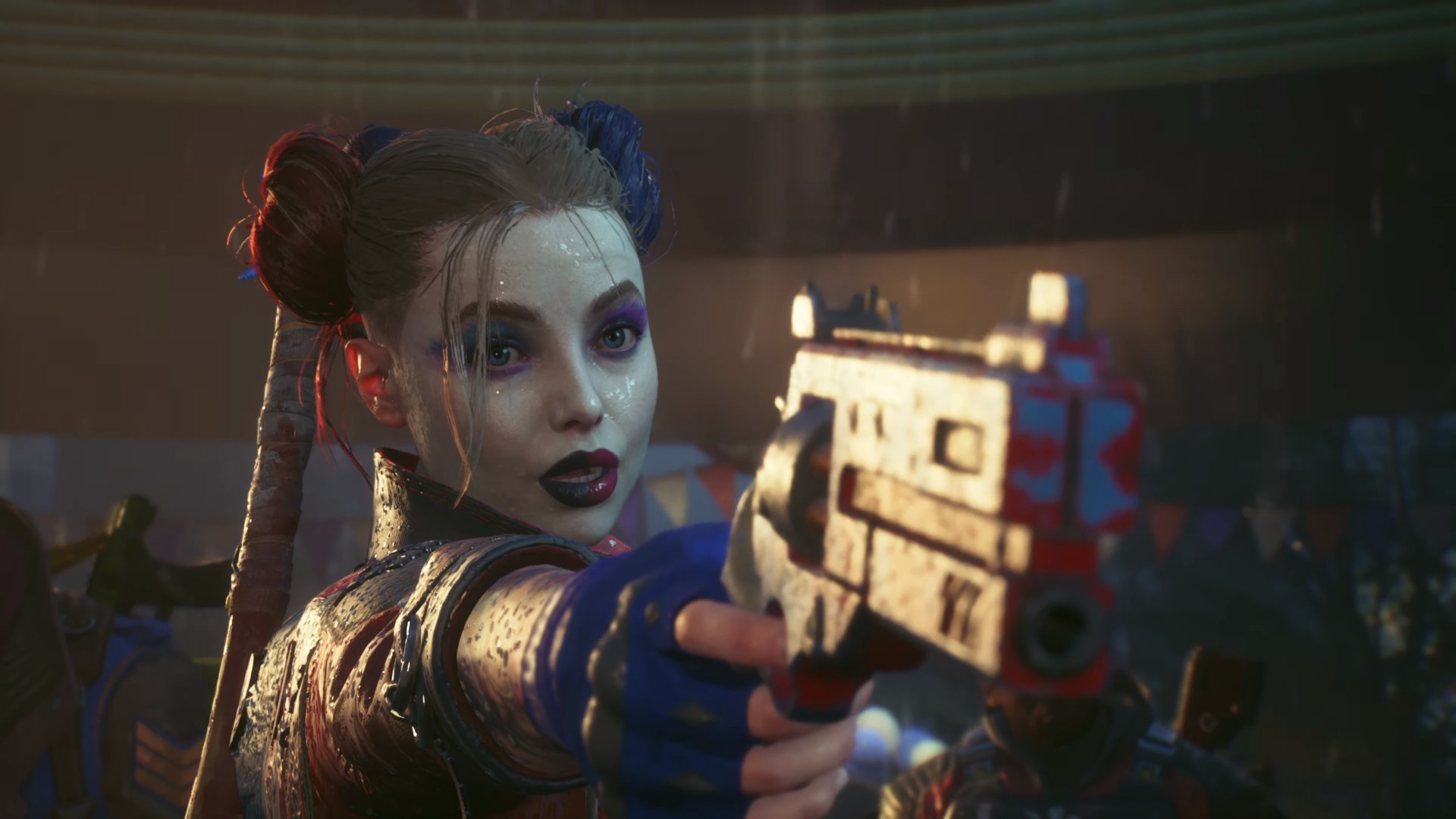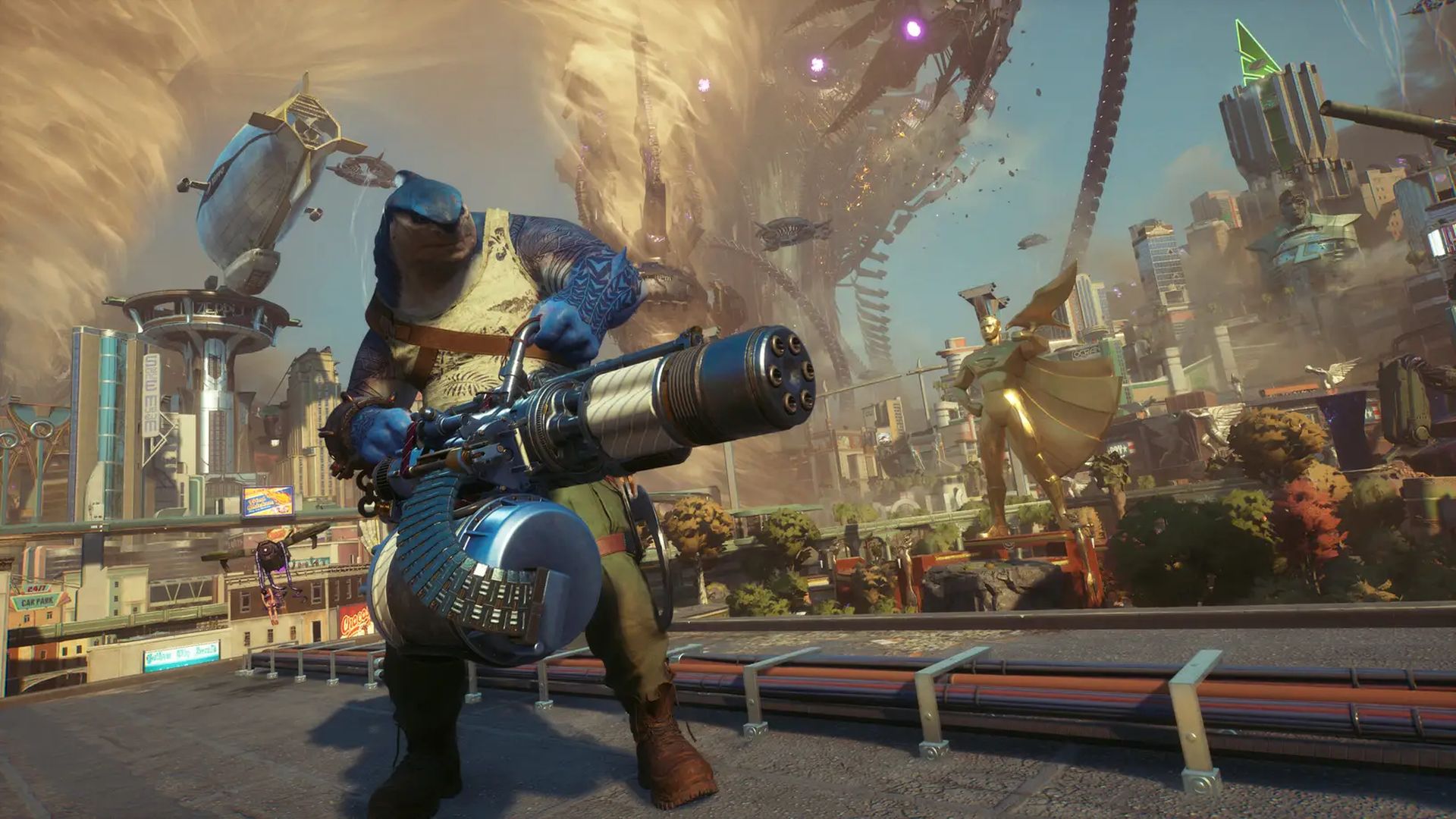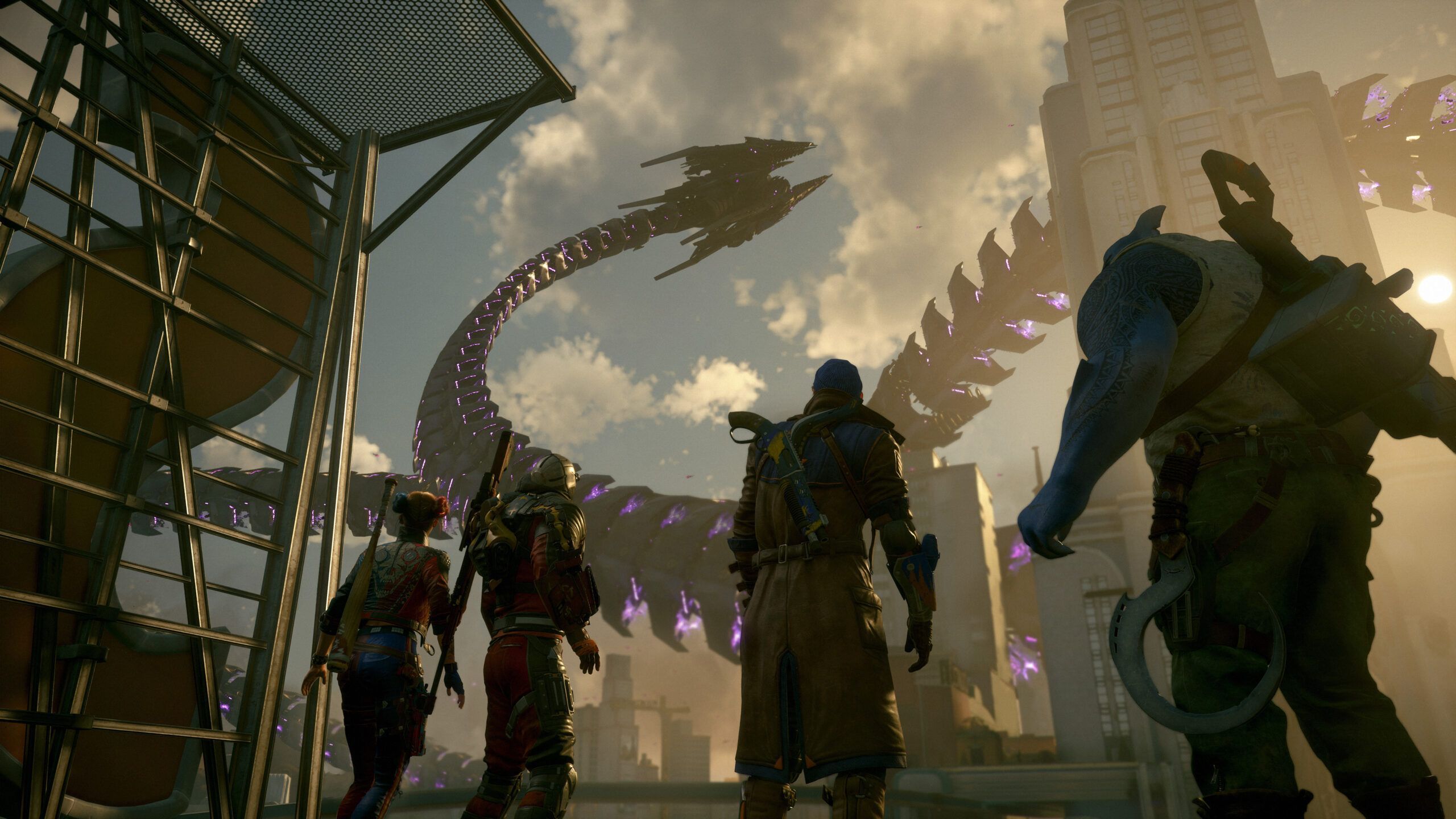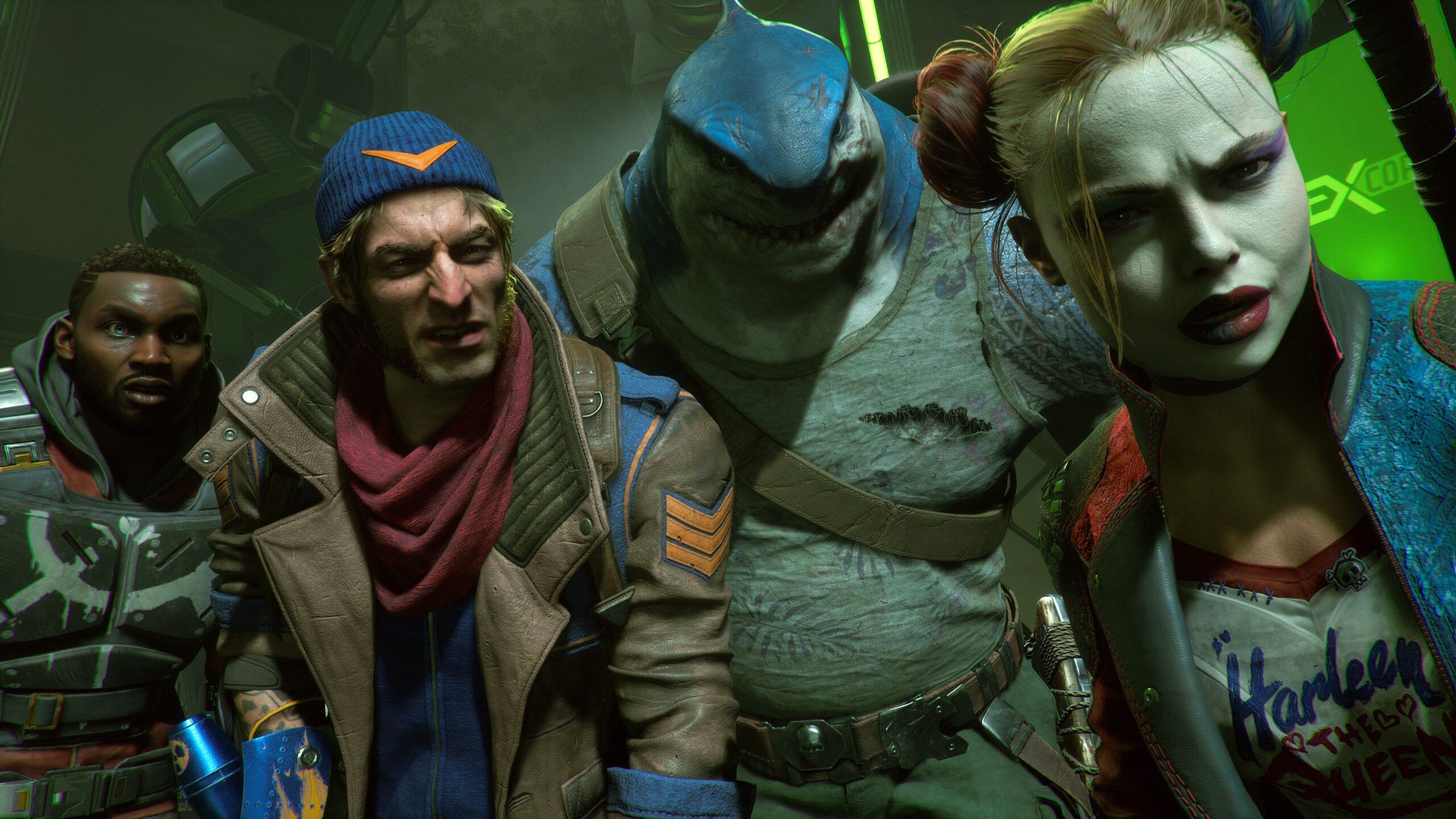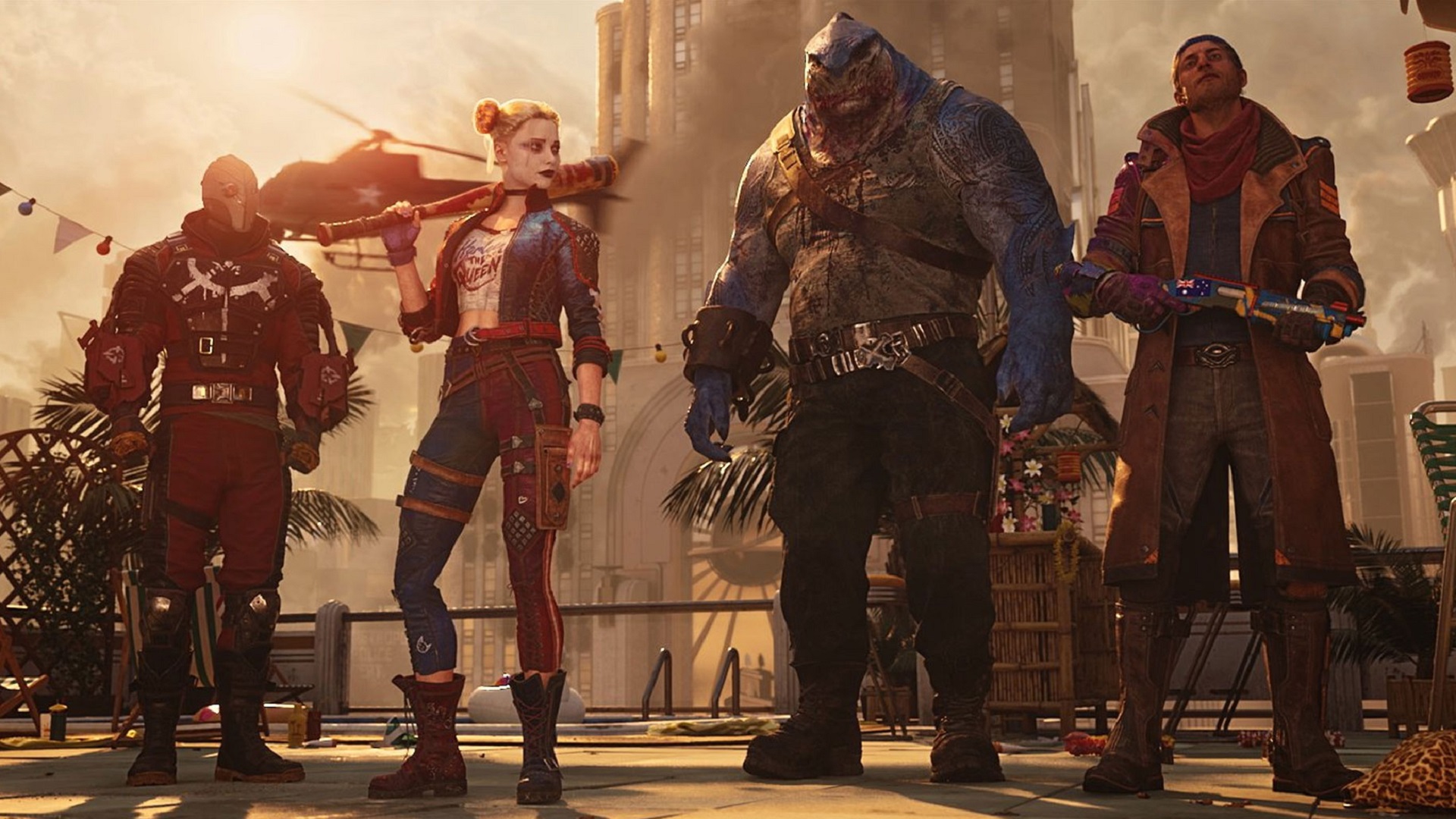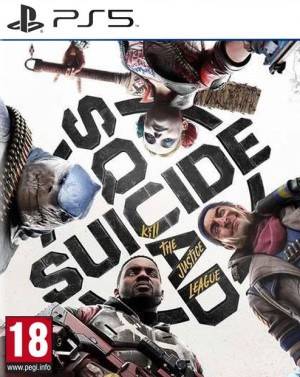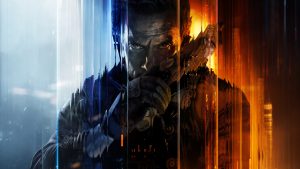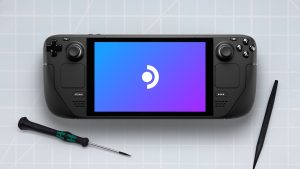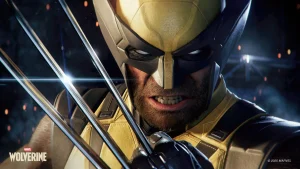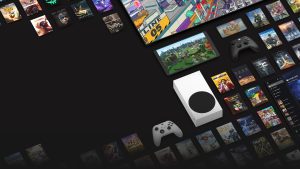
Explosions. Quips galore. Multiverses. References to other better franchises. Not one but two slow-mo shots of its casting walking with purpose. Suicide Squad: Kill the Justice League is truly the equivalent of the modern-day superhero blockbuster.
By now, you already know that Rocksteady of the legendary Batman: Arkham series is the developer. Set after those games, Suicide Squad: Kill the Justice League veers away from beat ’em up combat and stealth to focus on third-person shooting and loot. It features Deadshot, Harley Quinn, King Shark and Captain Boomerang, recruited by Amanda Waller of A.R.G.U.S. With nanite bombs embedded in their skulls, they simply need to pull off one job to have their sentences commuted – kill the Justice League.
As it turns out, Brainiac has invaded Metropolis and is collecting data to recreate his bygone planet of Colu. A brain-washed Superman, Green Lantern, Batman and eventually The Flash do his bidding while he turns people into Terminauts – some strangely resembling the Reaper troopers from Mass Effect 3. Wonder Woman still maintains control of herself, and while hung up on helping her friends, she’s also torn about doing the right thing and ending them once and for all.
"The problem is the pacing, as the first two hours or so offer more cutscenes than gameplay. Missions are constantly broken up with radio chatter, slowing you to crawl as you meander back and forth."
Right off the bat, it bears asking – Martian Manhunter? Green Arrow? Aquaman? The dozens of other Justice League members and superheroes in the DC lore? None of them were available to take on the evil League? Heck, none of the other villains or anti-heroes like Black Adam thought to step up either.
Instead, we have the guy who shoots good, an acrobatic former psychologist who also shoots good and Captain Boomerang? King Shark feels like the only legitimate threat (rather fitting since he’s voiced by wrestler Samoa Joe). Surprise, surprise, he’s usually the most charming. It certainly helps that the cutscenes and performances from its cast are top-notch. Debra Wilson does a solid no-nonsense job as Waller, and Kevin Conroy delivers an excellent post-humous performance as Batman.
The problem is the pacing, as the first two hours or so offer more cutscenes than gameplay. Missions are constantly broken up with radio chatter, slowing you to crawl as you meander back and forth. It also doesn’t help that the Squad goes back and forth, even while exploring. Some dialogue is fine, potentially passing for your average comic book quips.
However, you also have stinkers like Harley telling you about a guy who pronounced “Open Sesame” incorrectly and how it was funny, and anyway, he’s dead now. Or Captain Boomerang talking about shoving things up places where the sun doesn’t shine. Even Rick Flag gets his gotchas while carrying a Danny Glover-esque “I’m getting too old for this” demeanor about three decades too early (and he’s still endearing).
"Sadly, whatever intrigue there may be eventually gives way to plot contrivances, lame outcomes and twists that serve no other purpose than to reinforce its live service trappings."
I’m not opposed to humor – it’s just that the constant chatter, the repeated jokes like the Suicide Squad not listening to the details or being bumbling idiots, begins to wear on you. Throw in the chatter from the nondescript henchmen, and it wasn’t long before I turned down the dialogue for some peace and quiet. Your mileage may vary, of course, and while there are some well-done moments, they’re few and far between all the noise. If the characters endear themselves to you, it’s primarily on the strength of the actors’ performances.
After the Squad is let loose, the setting becomes more established. We see the fallout of Brainiac’s invasion and how it affected the likes of Lois Lane and Wonder Woman, not to mention the burned-out remains of the city. The attention to detail is pretty immaculate – superhero advertisements and statues in ruins, interspersed with random acts of destruction like a submarine tossed onto a building.
Meanwhile, the tentacles of Brainiac’s Skull Ship slink about menacingly, transporting enemy squads onto the streets. Even the weather effects look sharp, and characters are animated pretty well, though some flat environmental textures can occasionally crop up. Sadly, whatever intrigue there may be eventually gives way to plot contrivances, lame outcomes and twists that serve no other purpose than to reinforce its live service trappings.
When exploring Metropolis, there isn’t much to do at first other than killing enemies and then shooting the big glowing spot on an artillery gun to destroy it. Or killing enemies and shooting some crystals that lead to an Incubator, and then destroying its big glowing spot.
"Repetition is a challenge for any action RPG and looter shooter, but this utter dearth of interesting objectives will wear on you. The utterly pathetic enemy variety doesn’t help either."
Eventually, other characters like Penguin, Hack, the resurrected Poison Ivy, Gizmo, and Toyman get involved with Task Force X, serving as the Support Squad. They’ll help craft weapons and gear, augment your loot with new stats, apply Afflictions to melee weapons (and eventually grenades), provide vehicles and help assign points to the three Talent trees. They populate your map with side missions, each unlocking new upgrades or facilities back at base. That is, after their respective crash courses, which involve killing enemies in specific ways.
Unfortunately, as you happen across their other side missions, they’re revealed to be the same as the tutorial versions. Stop some enemies from taking over a point while Hack is hacking it – which is hilarious because they can do so without even being on it, and only take damage from Shield Harvests. Counter-Shot some enemies to please Luthor. Kill some enemies and deposit their bits back at Toyman’s toy truck turned huge. Or, my favorite, kill some enemies, wait for civilians to spawn, then rescue them with Legally Distinct Pokeballs (aka Pal Spheres) and transport them back to Rick Flag’s bus.
Other mission types, from escorting vehicles that stop until you take out some towers to gathering bits and depositing them at a signal booster thingamajig aren’t much better. Repetition is a challenge for any action RPG and looter shooter, but this utter dearth of interesting objectives will wear on you.
The utterly pathetic enemy variety doesn’t help either. You have the Grunts, Shotgunners, Brutes, Brute-ier Brutes, Snipers and the little creeps that lunge at you. Alien tanks and choppers also get in the way occasionally. Imagine fighting those for hours on end.
"The shooting also feels good – it’s a far cry from, say, Sunset Overdrive when comparing other movement-based third-person shooters, but it works."
Eventually, certain foes are “infused” with the properties of heroes like the Flash and Batman. Imagine the Sniper, the most annoying enemy type in the game, capable of shooting you across the map to suppress your movement abilities and teleporting if you get too close. Now it has stealth camo and doesn’t have a Counter-Shot indicator. Fun.
It’s a shame because Suicide Squad: Kill the Justice League does have something going for it with the combat. Each character has a unique traversal method, from Deadshot’s jetpack to Harley Quinn’s grapple. On the surface, they may not seem like much and feel unwieldy at first, but you get the hang of it.
The responsive controls make it easy to teleport across large distances as Captain Boomerang while King Shark’s leaps and high jumps pack the expected destructive grace. While each ability requires recharging, you can mitigate that by wall-climbing or sliding as soon you touch the ground. Eventually, it becomes fun to chain movement abilities, though Harley’s could use some work in the traversal speed.
Other elements are slowly worked in like melee hits to juggle enemies for guaranteed crits, Shield Harvesting to top up your shields, Traversal Attacks, and Suicide Strikes, which can usually take down enemies in a single hit. The shooting also feels good – it’s a far cry from, say, Sunset Overdrive when comparing other movement-based third-person shooters, but it works. If nothing else, I can appreciate how every element of the combat system, from the Gears of War-style timed reloads to the ability to float in mid-air and gun down enemies, is expanded upon with further Talents and loot.
"Further harming the game are the boss battles…They’re some of the worst boss fights that Rocksteady has ever designed, which is saying something."
There are some problems, though. The melee combat is pretty barebones. The sheer amount of effects from grenades, enemy attacks, environmental occurrences and whatnot can get more overwhelming as you go along, to the point where the otherwise solid performance starts to chug (that too after turning off damage numbers). As for the Talents, while they can offer some game-changing abilities – like reducing the cooldown on traversal methods with kills or damage reduction – their illusion of choice is most annoying. You get 30 Talent Points spread across the three trees.
You can only choose one Talent from each of the 10 Tiers in a single tree. Even if you have a Talent Point and want to invest it in a previous Talent, you can’t. If you expect something like Borderlands, where Skills become stronger as you invest more Skill Points, that’s not what Suicide Squad offers. Maybe it’s for balance’s sake, especially when Infamy Sets and Notorious Weapons come into play.
Further harming the game are the boss battles. You only really fight the four brain-washed members of the Justice League (not including the final boss), but almost every battle takes place in an open-air arena. They’re also some of the worst boss fights that Rocksteady has ever designed, which is saying something. The Flash constantly runs around, eventually generating tornados that can ragdoll you all over the place – like someone took a look at the Sirus fight in Path of Exile and thought it was peak.
You’re constantly readjusting to find him, nail a Counter-Shot and get a few shots in before he’s gone again. Green Lantern is somewhat better, though it boils down to “shoot the big glowing green things” – Counter-Shots destroy them faster – and then shooting him directly. The less said about Batman’s fight, the better. Superman at least has freeze breath, eye lasers and throws vehicles at you, but it all boils down to, once again, hitting him with a Counter-Shot to increase the damage he takes from your bullets. It’s a mess, but the climactic final battle is even more disappointing.
"Surely, there are some new activities and objectives that encourage different ways of playing. Wrong. You play the same activities that have been done to death in the main game."
Once we’ve got things like “plot” and “narrative” alongside such mundanities as a “satisfying conclusion” out of the way, more Support Squad Missions become available – be still o hammer hovering dangerously close to my DualSense. However, the main impetus for continuing is the endgame. The Elseworlds (or the one Elseworld, at least) can be explored via Incursion Missions to earn sick loot. Your goal is to venture into the Elseworld, complete an objective and escape via the portal.
Surely, there are some new activities and objectives that encourage different ways of playing. Wrong. You play the same activities that have been done to death in the main game. Acquire some charges and deposit them into a signal booster. Destroy some crystals and Incubators, except now there are five. Help Poison Ivy clear enemies away from her plants, which can fail easily, even if a single enemy or two is left alive and busy attacking you. The fact that there are only these three activities is mind-boggling until you learn that they must be repeated ad nauseam.
You must complete an Incursion on higher and higher Mastery Tiers for all three activities to unlock the later ones. The higher Mastery Tiers throw in some modifiers, like tougher enemies or foes evolving into Brutes and whatnot, that add to the difficulty but do little to ease the repetition.
There are also Raising Hell ranks to earn as you complete tasks in Metropolis and Invasion Levels, which level up the enemies and missions in the open world while providing more resources and XP. Completing missions in the post-game also grants Promethium required to access the Incursions in the first place.
"Bane is the theme for the current Infamy sets, as you inflict Venom Frenzy onto enemies, shoot them to gain a buff, which increases grenade damage, and go to town."
As your Finite Crisis Rank increases from completing Incursions – are you still with me on all this? – you unlock higher Tiers of Infamy Sets with specific bonuses (which still need to be earned by completing Incursions at higher Mastery Tiers).
Eventually, a Horde Mode-like activity, Killing Time unlocks and allows for earning more Promethium at a faster rate, though the end loot is often abysmal. A Hardcore version also becomes available, allowing you to extract at any time instead of waiting for the timer to run out but with no revives. Both versions would be acceptable if you didn’t have to traverse large empty expanses of an Elseworld to find enemies or have some unique objectives to complete (outside of the combat challenges that demand doing specific things), but alas.
Hit Finite Crisis Rank 30, and a new Incursion Mission, Mayhem, opens up, allowing you to challenge the final boss at a higher difficulty and demanding a whopping 3000 Promethium. Would it have been better if the final fight wasn’t a chore? Probably. It’s a more bullet-spongey version of a battle that was already a massive disappointment, story and gameplay-wise, so I’ll pass.
As noted earlier, I can appreciate some of the thought that went into the Infamy Sets and weapons. Bane is the theme for the current Infamy sets, as you inflict Venom Frenzy onto enemies, shoot them to gain a buff, which increases grenade damage, and go to town. A Legendary grenade that constantly drops your shields but grants 500 percent more damage with the grenade suddenly becomes a strong pick.
"Perhaps the only standout feature is the Social Squad, which allows your bots to have the gear of other players, including the leaderboard’s top-tier performers."
That’s only Tier 1 – Tier 2 can provide benefits like gaining 1 percent damage per every 1 percent health an enemy loses. Throw in some Infamy sets for other villains like Black Mask, Two-Face and Hugo Strange, some capable of forming Villain Synergies and the ability to have multiple set bonuses and Synergies active, and there’s a lot to unwrap.
A Paragon-style system akin to Diablo 3 for further leveling and assigning incremental bonuses to weapon damage, damage resistance and so forth, are also in place. It’s pretty straightforward, almost to the point of boredom, but offers yet another way to gain power over time.
As you focus on a single character and level them up, other characters will auto-equip what should be stronger gear. However, they won’t level up and thus won’t gain Talent Points unless you assume control directly. The crafting system is solid but simplistic, with Toyman’s ability to reroll a single augment on weapons and gear at the cost of locking the other augments ripped straight from the Mystic in Diablo 3.
Perhaps the only standout feature is the Social Squad, which allows your bots to have the gear of other players, including the leaderboard’s top-tier performers. I didn’t feel the need, especially since the hit-or-miss nature of the AI, which alternated between shooting at an already damaged Incubator to executing Suicide Strikes with aplomb, didn’t inspire much confidence.
"Suicide Squad: Kill the Justice League isn’t an outright disaster. It’s better than Marvel’s Avengers, especially with the loot and combat mechanics."
At its core, Suicide Squad: Kill the Justice League is exactly what WB Games likely envisioned for it – a live-service platform that it can build on and monetize for an extended period. As a story, it’s ultimately a waste of time and little more than a setup for extensive busywork.
The loot and shooting mechanics are acceptable, even if the melee combat is middling. The activities range from dull and repetitive to mind-numbing, and even with the promise of better loot and set bonuses, the Mutators and Mastery Tiers don’t do nearly enough to liven up the endgame.
While it can be visually pleasing, especially as you look out on the destroyed Metropolis, you’re ultimately seeing a hollow shell – little more than a movie backdrop, where the extras only come out in the required scenes and nowhere else. If only the suspension of belief was strong enough to convince me otherwise.
Suicide Squad: Kill the Justice League isn’t an outright disaster. It’s better than Marvel’s Avengers, especially with the loot and combat mechanics. It’s better than Anthem at launch (post-launch is a toss-up). It’s better than Redfall when considering overall polish. It’s all damning with faint praise, though. If anything, the game oscillates between mediocrity, above-averageness, and a big bowl of “What am I doing with my life?”. Once the dopamine hits stop, all that’s left are the ashes of a developer capable of so much better.
This game was reviewed on PlayStation 5.
The visuals, from the character models and effects to the cutscenes, look good. Combat and traversal can be fun, especially as more options and loot becomes available. Intriguing premise, backed by great performances all around.
Plodding pace for the first few hours. Horrendous dialogue and humor every now and again. Second half of the story goes off the deep end. Lacking enemy variety. Not a single good boss fight. Terrible ending that renders almost everything pointless. Dull missions that add to the repetition. Endgame offers nothing more than the same handful of missions to grind. Characters don't level up at the same time, adding to the grind. For all of its good looks, Metropolis is little more than a backdrop.









